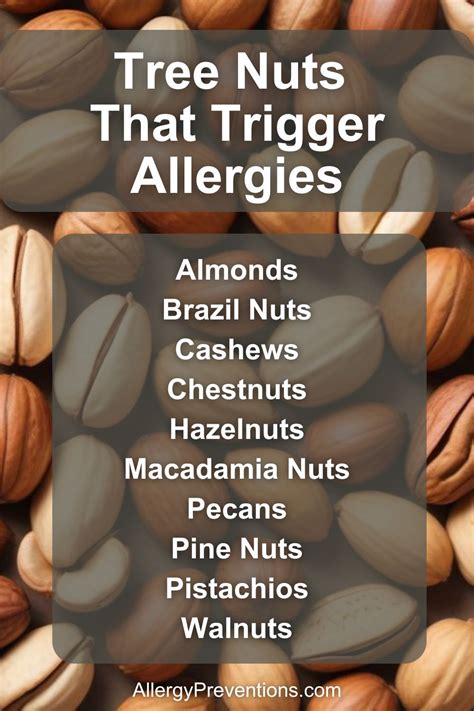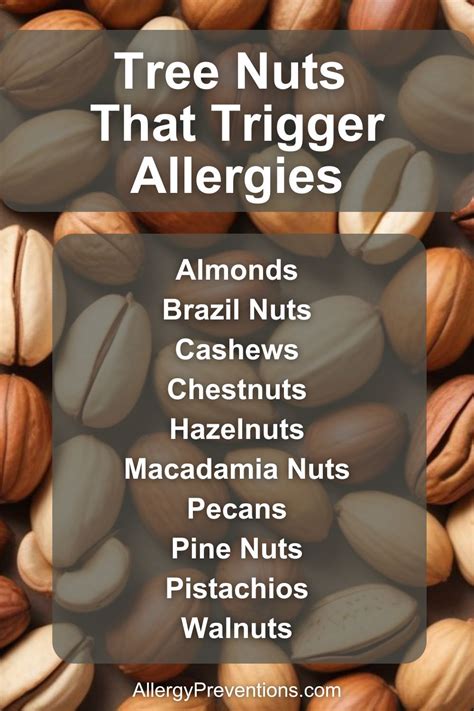Intro
Manage tree nut allergies with 5 expert tips, covering symptoms, treatment, and prevention, including food avoidance, epinephrine use, and nut-free diets.
Tree nut allergy is a common and potentially life-threatening condition that affects millions of people worldwide. It is characterized by an overreaction of the immune system to one or more proteins present in tree nuts, leading to a range of symptoms from mild hives to anaphylaxis. Managing a tree nut allergy requires a combination of vigilance, education, and proactive strategies to minimize the risk of exposure and ensure timely treatment in case of an allergic reaction.
Living with a tree nut allergy can be challenging, especially in social situations or when eating out, as tree nuts are common ingredients in many foods. However, with the right approach, individuals with tree nut allergies can lead active, healthy lives. This involves understanding the nature of tree nut allergy, recognizing the signs of an allergic reaction, and being equipped with the knowledge and tools to respond appropriately. It also requires a supportive environment, where family, friends, and community members are aware of the condition and know how to offer assistance when needed.
The prevalence of tree nut allergies has been increasing over the years, making it essential for the general public to be informed about this condition. By promoting awareness and understanding, we can create a more inclusive and safer environment for those affected. This includes recognizing the importance of food labeling, the role of medical alert devices, and the need for emergency preparedness. As we delve into the specifics of managing tree nut allergies, it becomes clear that a multifaceted approach is necessary, combining medical guidance, lifestyle adjustments, and community support.
Understanding Tree Nut Allergy

Diagnosis of Tree Nut Allergy
Diagnosing a tree nut allergy typically involves a combination of medical history, physical examination, and diagnostic tests. Skin prick tests and blood tests are commonly used to identify the presence of tree nut-specific IgE antibodies, which are indicative of an allergic reaction. An elimination diet, where the suspected allergenic food is removed from the diet for a period and then reintroduced under medical supervision, can also be helpful in diagnosing a tree nut allergy.Managing Tree Nut Allergy

Prevention Strategies
Preventing exposure to tree nuts is crucial for individuals with a tree nut allergy. This includes: - Avoiding foods that contain tree nuts or are processed in facilities that also handle tree nuts. - Being cautious with baked goods, granolas, and energy bars, which often contain nuts. - Informing friends, family, and colleagues about the allergy to ensure they understand the risks and can offer support.Treatment and Emergency Response

Living with Tree Nut Allergy
Living with a tree nut allergy requires ongoing vigilance but does not have to limit one's quality of life. By staying informed, being prepared, and maintaining open communication with healthcare providers, family, and friends, individuals with tree nut allergies can enjoy a full and active life. This includes participating in sports, traveling, and socializing, all while taking necessary precautions to avoid exposure and ensure timely treatment in case of an emergency.Nutritional Considerations

Dietary Alternatives
For those with tree nut allergies, exploring dietary alternatives can be both necessary and rewarding. This might include: - **Sunflower seeds and pumpkin seeds:** Rich in healthy fats and proteins, these seeds can be a good substitute in many recipes. - **Soy nuts and pea nuts:** Though not tree nuts, these can provide a similar crunch and nutritional profile in some dishes. - **Fresh fruits and vegetables:** Increasing the intake of a variety of fruits and vegetables can help compensate for the loss of nutrients from tree nuts.Support and Community

Advocacy and Awareness
Advocating for awareness and understanding of tree nut allergies is an important part of creating a safer and more inclusive environment. This can involve participating in awareness campaigns, supporting research into food allergies, and encouraging schools and public places to adopt allergy-friendly policies. By working together, we can reduce the risks associated with tree nut allergies and improve the quality of life for those affected.Future Directions

Emerging Therapies
Emerging therapies for tree nut allergy include: - **Sublingual immunotherapy:** Similar to OIT but involves placing a small amount of the allergen under the tongue. - **Anti-IgE therapy:** Targets the IgE antibodies responsible for the allergic reaction. - **Probiotics and prebiotics:** May help modify the gut microbiome to reduce allergy severity.As we look to the future, it is clear that managing tree nut allergies will continue to involve a combination of medical treatment, lifestyle adjustments, and community support. By staying informed, advocating for awareness, and supporting research, we can work towards a future where tree nut allergies are better understood, more effectively managed, and perhaps one day, a thing of the past.
Inviting readers to share their experiences and tips on managing tree nut allergies can foster a sense of community and provide valuable insights for others facing similar challenges. Whether you are personally affected by a tree nut allergy or know someone who is, your story and advice can make a difference. Let's work together to create a more inclusive and supportive environment for everyone, regardless of their dietary restrictions or health conditions. Share this article with someone you know who might benefit from its information, and let's continue the conversation on social media using relevant hashtags to raise awareness about tree nut allergies.
What are the most common tree nuts that cause allergies?
+The most common tree nuts that cause allergies are walnuts, almonds, cashews, hazelnuts, and pecans.
How is a tree nut allergy diagnosed?
+A tree nut allergy is diagnosed through a combination of medical history, physical examination, skin prick tests, and blood tests to identify the presence of tree nut-specific IgE antibodies.
What should I do if I accidentally ingest a tree nut and have an allergy?
+If you accidentally ingest a tree nut and have an allergy, administer epinephrine if available, and immediately call emergency services or seek medical attention.
